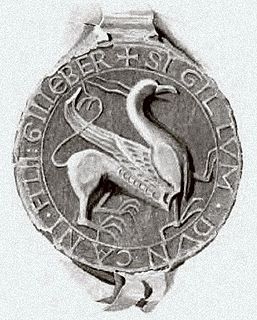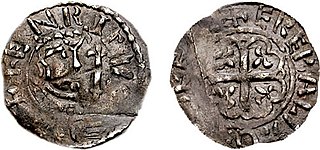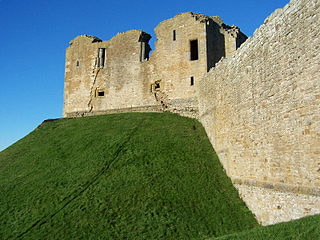Related Research Articles

The Battle of Largs was a decisive, albeit small, battle between the kingdoms of Norway and Scotland, on the Firth of Clyde near Largs, Scotland. Like the Japanese victories over the Mongol Invasions at roughly the same time or the much later Battle of Coral Sea, Scotland achieved the end of 500 years of Norse Viking depredations and invasions despite being tremendously outnumbered, without a one-sided military victory in the ensuing battle. That said, the victory caused the complete retreat of Norwegian forces from western Scotland and the realm entered a period of prosperity for almost 40 years. The tactical decision at Largs thus led to a sweeping strategic victory that ended in Scotland purchasing the Hebrides Islands and the Isle of Mann in the Treaty of Perth, 1266. Victory was achieved with a crafty three-tiered strategy on the part of the young Scottish king, Alexander III: plodding diplomacy forced the campaign to bad weather months and a ferocious storm ravaged the Norwegian fleet, stripping it of many vessels and supplies and making the forces on the Scottish coast vulnerable to an attack that forced the Norwegians into a hasty retreat that was to end their 500-year history of invasion and leave Scotland to consolidate its resources into building the nation. The conflict formed part of the Norwegian expedition against Scotland in 1263, in which Haakon Haakonsson, King of Norway attempted to reassert Norwegian sovereignty over the western seaboard of Scotland.

Donnchadh was a Gall-Gaidhil prince and Scottish magnate in what is now south-western Scotland, whose career stretched from the last quarter of the 12th century until his death in 1250. His father, Gille-Brighde of Galloway, and his uncle, Uhtred of Galloway, were the two rival sons of Fergus, Prince or Lord of Galloway. As a result of Gille-Brighde's conflict with Uhtred and the Scottish monarch William the Lion, Donnchadh became a hostage of King Henry II of England. He probably remained in England for almost a decade before returning north on the death of his father. Although denied succession to all the lands of Galloway, he was granted lordship over Carrick in the north.
Somerled, known in Middle Irish as Somairle, Somhairle, and Somhairlidh, and in Old Norse as Sumarliði, was a mid-12th-century Irish-Norse-Gaelic lord who, through marital alliance and military conquest, rose in prominence to create the Kingdom of Argyll and the Isles. Little is certain of Somerled's origins, although he may have been born in northern Ireland and appears to have belonged to a Norse–Gaelic family of some prominence. His father, GilleBride, of royal Irish ancestry, appears to have conducted a marriage alliance with Máel Coluim mac Alaxandair, son of Alexander I of Scotland, and claimant to the Scottish throne. During a period of alliance with David I of Scotland, Somerled married Ragnhild, daughter of Óláfr Guðrøðarson, King of Man and the Isles in 1140. In 1153, Olaf of Man died and was succeeded by his son, Godred. But Godred Olafsson was a very unpopular ruler. Somerled was asked by Thorfinn Ottarson, a Manx chief, to allow Somerled's son, Dugall, to be appointed king of Man and the Isles. Somerled agreed and with 80 ships confronted Godred off the coast of Islay on January 5–6, 1156. After the sea battle, Somerled and Godred divided the Kingdom of Man and the Isles between them but Godred did not accept Dugall as King of Man. Accordingly, two years later, Somerled defeated and drove Godred from power. Dugall continued as King of Man and Somerled thus ruled the entire kingdom of Argyll, Man and the Isles until his death.
The Kingdom of Alba was the Kingdom of Scotland between the deaths of Donald II in 900 and of Alexander III in 1286, which then led indirectly to the Scottish Wars of Independence. The name is one of convenience, as throughout this period the elite and populace of the Kingdom were predominantly Pictish-Gaels or later Pictish-Gaels and Scoto-Norman, and differs markedly from the period of the House of Stuart, in which the elite of the kingdom were speakers of Middle English, which later evolved and came to be called Lowland Scots. There is no precise Gaelic equivalent for the English terminology "Kingdom of Alba", as the Gaelic term Rìoghachd na h-Alba means 'Kingdom of Scotland'. English-speaking scholars adapted the Gaelic name for Scotland to apply to a particular political period in Scottish history during the High Middle Ages.
The Battle of Renfrew was fought between the Kingdom of the Isles and the Kingdom of Scotland in 1164, near Renfrew, Scotland. The men of the Isles, accompanied by forces from the Kingdom of Dublin, were commanded by Somairle mac Gilla Brigte, King of the Isles. The identity of the Scottish commander is unrecorded and unknown. Herbert, Bishop of Glasgow, Baldwin, Sheriff of Lanark/Clydesdale, and Walter fitz Alan, Steward of Scotland are all possible candidates for this position. The battle was a disaster for the Islesmen and Dubliners. Somairle was slain in the encounter, apparently by local levies, and his forces were routed.

Henry of Scotland was heir apparent to the Kingdom of Alba. He was also the 3rd Earl of Northumberland and the 3rd Earl of Huntingdon. He was the son of King David I of Scotland and Queen Maud, 2nd Countess of Huntingdon.
Professor Richard D. Oram F.S.A. (Scot.) is a Scottish historian. He is a professor of medieval and environmental history at the University of Stirling and an honorary lecturer in history at the University of Aberdeen. He is also the director of the Centre for Environmental History and Policy at the University of Stirling.
Walter FitzAlan was a twelfth-century Scottish magnate and Steward of Scotland. He was a younger son of Alan fitz Flaald and Avelina de Hesdin. In about 1136, Walter entered into the service of David I, King of Scotland. He became the king's dapifer or steward in about 1150, and served as such for three successive Scottish kings: David, Malcolm IV, and William I. In time, the stewardship became hereditarily-held by Walter's descendants.

Freskin was a Flemish nobleman who settled in Scotland during the reign of King David I, becoming the progenitor of the Murray and Sutherland families, and possibly others.
Hugh de Morville of Appleby in Westmorland, England, hereditary Constable of Scotland, was a Norman knight who made his fortune in the service of David FitzMalcolm (d.1153), Prince of the Cumbrians, later King of Scotland.

The Davidian Revolution is a name given by many scholars to the changes which took place in the Kingdom of Scotland during the reign of David I (1124–1153). These included his foundation of burghs, implementation of the ideals of Gregorian Reform, foundation of monasteries, Normanization of the Scottish government, and the introduction of feudalism through immigrant Norman and Anglo-Norman knights.

Roberton is a village in South Lanarkshire, Scotland.
The Battle of Stracathro, also known as the Battle of Inchbare, took place on 16 April 1130 about three miles (4.8 km) north of Brechin, Scotland, near the River North Esk.
Waltheof of Allerdale was an 11th- and 12th-century Anglo-Saxon noble, lord of Allerdale in modern Cumbria. Brother of Dolfin of Carlisle and Gospatric of Dunbar, Waltheof was son of Gospatric, Earl of Northumbria. Both Waltheof and his brother Gospatric witness Earl David's Glasgow Inquest 1113 x 1124, and Waltheof also attests some of David's charters as king of the Scots later. The account of Waltheof and his family in Cumbrian monastic cartularies, says that he gave land in Allerdale to his three sisters, Octreda, Gunhilda and Maud.
Coleraine Castle was a castle situated at Coleraine, County Londonderry, Northern Ireland.
Robert Avenel was a 12th-century Anglo-Norman magnate. He was ruler of the small former Northumbrian province of Eskdale in Dumfriesshire, as well as Abercorn in West Lothian. He was one of a small number of Anglo-Norman immigrants to have been given a provincial lordship in southern Scotland in the early-to-mid 12th century. For some period in the 1170s he served as Justiciar in Lothian. He also had some part of the township of Innerwick. He seems to have held this of Walter fitz Alan. He passed this on to his younger son Vincent. His nephew Glai or Glay may have held part of Innerwick too.
Ailéan mac Ruaidhrí was a leading figure in the thirteenth-century kingdoms of the Isles and the Scotland. He was a son of Ruaidhrí mac Raghnaill, and thus a member of the Clann Ruaidhrí branch of Clann Somhairle. Ailéan was a brother of Dubhghall mac Ruaidhrí, King of Argyll and the Isles, a significant figure who held power in the mid thirteenth century. At the time, the rulers of the Isles were fiercely independent of the Scottish Crown, and owed nominal allegiance to the distant Norwegian Crown. In 1259, Dubhghall's daughter married the son of King of Connacht, and Ailéan is recorded to have commanded the woman's tocher of one hundred and sixty gallowglass warriors.
Events from the year 1202 in the Kingdom of Scotland.
Nicholas was a twelfth-century Bishop-elect of the Isles. There is no evidence that he was ever consecrated.
The Scottish expedition into Argyll (1221–1222) was a Scottish expedition into Argyll and the surrounding region. The expedition led by King Alexander II of Scotland, appears to have been undertaken to counter the threat of Clann Somhairle and alliances created between the Crovan dynasty of the Isle of Man and Ailean mac Lachlainn, Lord of Galloway and Constable of Scotland and old alliances with the Meic Uilleim and MacHeths. The sub kingdom of Argyll was brought into the Kingdom of Scotland, after expelling Ruaidhrí mac Raghnaill from the area and the submission and swearing of fealty given by Donnchadh of Argyll. Alexander II set about formalising Norman feudal law and Scottish administration of the area and ordered the building of royal castles at Dunoon, Cowal and Tarbet, Kintyre.
References
- ↑ Oram, Richard D. (2011), Domination and lordship: Scotland 1070–1230, The new Edinburgh history of Scotland, Edinburgh University Press, p. 128, ISBN 978 0 7486 1496 7 . – via Google Books
- 1 2 Oram, Richard D. (2011), Domination and lordship: Scotland 1070–1230, The new Edinburgh history of Scotland, Edinburgh University Press, p. 316, ISBN 978 0 7486 1496 7 . – via Google Books
- ↑ Barrow, Geoffrey Wallis Steuart (2003), The kingdom of the Scots: government, church and society from the eleventh to the fourteenth century, Edinburgh University Press, pp. 320–321, ISBN 0 7486 1802 3 . – via Google Books
- ↑ Barrow, Geoffrey Wallis Steuart (2003), The kingdom of the Scots: government, church and society from the eleventh to the fourteenth century, Edinburgh University Press, pp. 319–320, ISBN 0 7486 1802 3 . – via Google Books